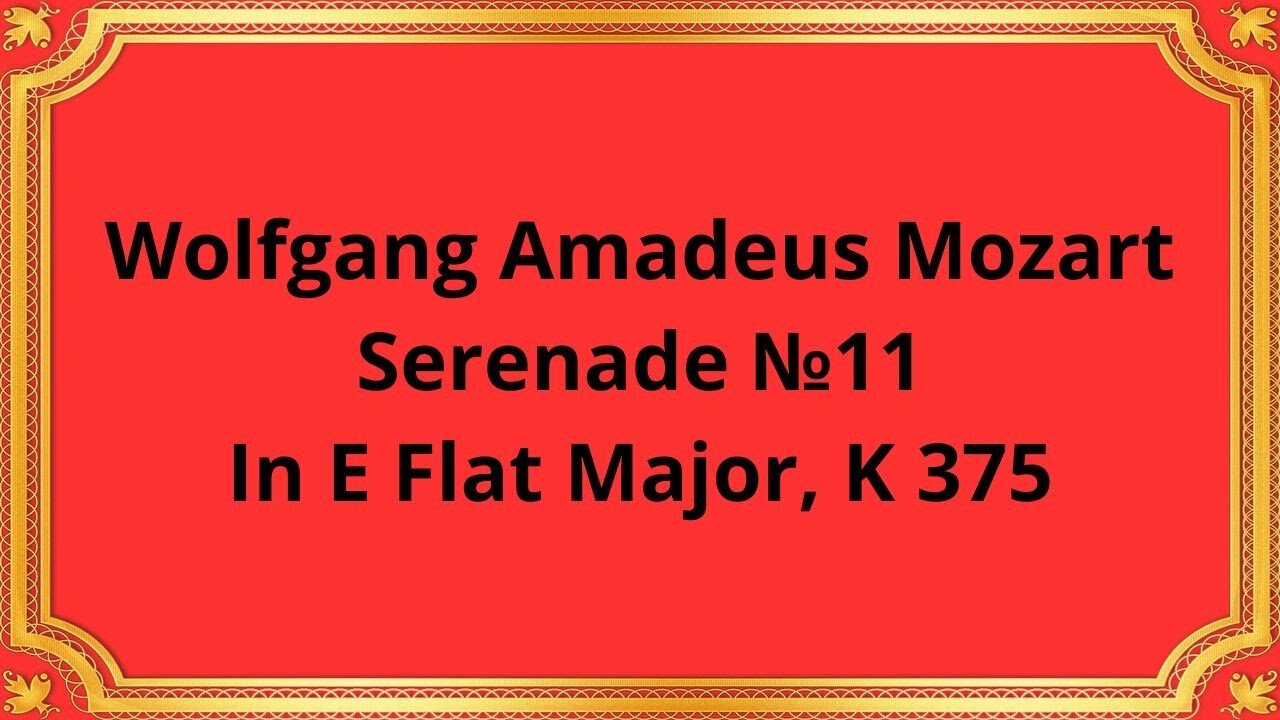Premium Only Content

Wolfgang Amadeus Mozart Serenade №11 In E Flat Major, K 375
#Mozart#Chamber_music#Classical_music#Serenade#Musical_composition
Wind Association of the Vienna Philharmonic
HANS KAMESCH
Oboe LEOPOLD WLACH IAP VV OBA
Oboe FRANZ BARTOSEK
Clarinet GOTTFRIED VON FREIBERG Fei,
Clarinet LEOPOLD KAINZ
Wolfgang Amadeus Mozart is one of the most influential composers in music history, and his Serenade No. 11 in E-flat major, K. 375, is a testament to his talent and skill. Composed in 1781, this serenade is one of Mozart's most popular works and is still performed today by orchestras around the world.
The Serenade No. 11 in E-flat major, K. 375, is a nine-movement work that follows the traditional serenade structure. It begins with a march, followed by a series of minuets, and ends with a rondo. The serenade is scored for two oboes, two clarinets, two bassoons, four horns, and a string section.
The first movement, the march, is a lively and energetic piece that sets the tone for the entire work. The second movement is a minuet in E-flat major that features a light and graceful melody. The third movement is a trio in C minor that provides a contrast to the previous minuet with its somber and melancholic tone.
The fourth movement is another minuet, this time in the key of E-flat minor. It is a slower and more expressive piece that features a beautiful melody played by the clarinets. The fifth movement is a trio in E-flat major that is more lively and upbeat than the previous trio.
The sixth movement is a slow and expressive adagio in B-flat major. It is a beautiful and melancholic piece that showcases Mozart's talent for melody and harmony. The seventh movement is another minuet, this time in the key of A-flat major. It is a lively and energetic piece that features a memorable melody played by the strings.
The eighth movement is a trio in A-flat major that is more subdued than the previous trio. It features a beautiful melody played by the oboes and is a perfect example of Mozart's talent for creating emotional and expressive music. The final movement is a rondo in E-flat major that features a lively and memorable theme played by the horns.
The Serenade No. 11 in E-flat major, K. 375, is a complex and sophisticated work that requires careful interpretation and execution. The opening march should be played with energy and precision, while the minuets should be light and graceful. The trio in C minor should be played with a somber and melancholic tone, while the trio in E-flat major should be more lively and upbeat.
The adagio in B-flat major is the emotional centerpiece of the work and should be played with great care and sensitivity. The final rondo should be played with energy and enthusiasm, with the memorable theme played by the horns standing out above the rest of the orchestra.
Conclusion:
Wolfgang Amadeus Mozart's Serenade No. 11 in E-flat major, K. 375, is a masterpiece of classical music that has stood the test of time. Its complex structure and sophisticated musical themes showcase Mozart's talent for creating emotional and expressive music. Whether played by a small ensemble or a full orchestra, this serenade is sure to delight audiences with its beauty and grace.
-
 3:14:33
3:14:33
Joe Donuts Gaming
9 hours ago🟢 Live : Christmas is Here!! | Fortnite, Caroling, Light Tours and Donos !!
38.8K11 -
 6:02:38
6:02:38
CLUJ
9 hours agoCHRISTMAS EVENING HYPE!! LETS HAVE FUN GAMING!!
36.6K6 -
![I AM FINALLY BACK :: PUBG: BATTLEGROUNDS :: RUMBLE NOW HAS GIFTED SUBS!!! [Merry Christmas] {18+}](https://1a-1791.com/video/fwe1/22/s8/1/e/f/C/6/efC6v.0kob-small-I-AM-FINALLY-BACK-PUBG-BATT.jpg) 9:57:19
9:57:19
a12cat34dog
11 hours agoI AM FINALLY BACK :: PUBG: BATTLEGROUNDS :: RUMBLE NOW HAS GIFTED SUBS!!! [Merry Christmas] {18+}
26K4 -
 3:55:42
3:55:42
STARM1X16
10 hours agoMerry Christmas Fortnite
73.5K8 -
 2:45:33
2:45:33
Sgtfinesse
10 hours agoMerry Christmas Night
61.1K18 -
 3:51:18
3:51:18
tacetmort3m
1 day ago🔴 LIVE - (MERRY CHRISTMAS) TIME TO SPREAD DEMOCRACY - HELLDIVERS 2 OMENS OF TYRANNY
34.4K2 -
 2:46
2:46
BIG NEM
13 hours agoDiscovering RAKIJA: The Holy Liquer of the Balkans
23.5K2 -
 1:11:38
1:11:38
Film Threat
18 hours agoCHRISTMAS DAY CHILL STREAM WITH CHRIS GORE | Hollywood on the Rocks
143K31 -
 14:22:40
14:22:40
The Quartering
1 day agoYule Log Christmas MAGA Edition With Memes! Come Hang Out!
232K29 -
 38:41
38:41
MYLUNCHBREAK CHANNEL PAGE
1 day agoTimeline Begins in 1800? - Pt 1 & 2
111K66